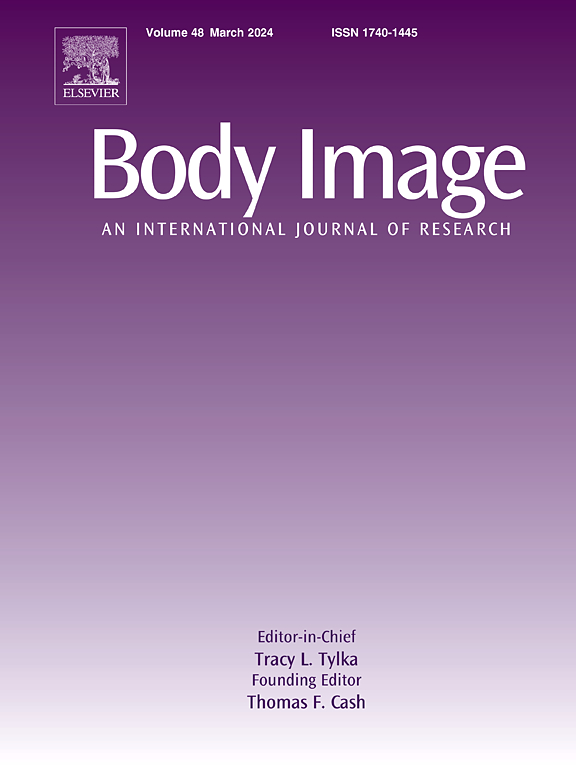Pilot trial assessing acceptability, feasibility, and preliminary effects of a body image intervention for adolescents in rural Nicaragua
IF 5.4
1区 心理学
Q1 PSYCHIATRY
引用次数: 0
Abstract
School-based interventions to promote body esteem and media literacy are a cost-effective way to improve body image and foster resilience against appearance pressures across diverse socio-economic contexts. We developed a culturally adapted intervention to promote body esteem and media literacy and piloted it in a two-arm semi-randomized controlled trial. Nicaraguan adolescents in two schools were allocated to receive a four-session, facilitator-delivered, school-based intervention that focused on critiquing appearance ideals, recognizing manipulated images, reducing social comparisons and resisting appearance pressures. Participants in two schools were allocated to the waitlist control condition. A total of 122 adolescents (77 girls, Mage = 13.7, SD = 1.55, range 11–18) answered questionnaires about body satisfaction, internalization of general and athletic ideals, sociocultural pressures, physical appearance comparison and eating attitudes before and one week after the intervention/control period; and completed open-ended questions at six-week follow-up. Throughout the program, they provided both qualitative and quantitative feedback after each session. Additional feedback was gathered from participants, observing teachers, and facilitators during focus groups at post-test to evaluate the program’s acceptability and feasibility. The intervention demonstrated good acceptability and feasibility. Participants showed improvements at post-test for perceived reality of social media and athletic internalization. Key learning points were retained at six-week follow-up. Our culturally adapted body image intervention is a feasible, acceptable, and promising tool to increase body esteem and media literacy in Nicaragua. These results suggest that after careful cultural adaptation, school-based body image interventions can be used in a variety of different cultural and socio-economic contexts.
评估尼加拉瓜农村青少年身体形象干预的可接受性、可行性和初步效果的试点试验
以学校为基础的促进身体尊重和媒体素养的干预措施是改善身体形象和培养在不同社会经济背景下抵御外貌压力的经济有效方式。我们开发了一种适应文化的干预措施,以促进身体尊重和媒体素养,并在一项两组半随机对照试验中进行了试验。两所学校的尼加拉瓜青少年被分配接受一项由辅导员提供的、以学校为基础的四期干预,重点是批评理想外表、识别被操纵的形象、减少社会比较和抵制外表压力。两所学校的参与者被分配到候补名单控制条件。共122名青少年(77名女生,Mage = 13.7, SD = 1.55,范围11 ~ 18)在干预/控制期前和干预/控制期后1周回答了身体满意度、一般理想和运动理想内化、社会文化压力、外表比较和饮食态度等问卷;并在六周的随访中完成开放式问题。在整个课程中,他们在每次课程结束后都提供定性和定量反馈。在测试后的焦点小组中,从参与者、观察教师和辅导员那里收集了额外的反馈,以评估项目的可接受性和可行性。该干预措施具有良好的可接受性和可行性。参与者在社交媒体感知现实和运动内化的后测中表现出改善。在6周的随访中保留了关键的学习点。我们的文化适应性身体形象干预是一种可行、可接受和有前途的工具,可以提高尼加拉瓜对身体的尊重和媒体素养。这些结果表明,经过仔细的文化适应,以学校为基础的身体形象干预可以在各种不同的文化和社会经济背景下使用。
本文章由计算机程序翻译,如有差异,请以英文原文为准。
求助全文
约1分钟内获得全文
求助全文
来源期刊

Body Image
Multiple-
CiteScore
8.70
自引率
28.80%
发文量
174
期刊介绍:
Body Image is an international, peer-reviewed journal that publishes high-quality, scientific articles on body image and human physical appearance. Body Image is a multi-faceted concept that refers to persons perceptions and attitudes about their own body, particularly but not exclusively its appearance. The journal invites contributions from a broad range of disciplines-psychological science, other social and behavioral sciences, and medical and health sciences. The journal publishes original research articles, brief research reports, theoretical and review papers, and science-based practitioner reports of interest. Dissertation abstracts are also published online, and the journal gives an annual award for the best doctoral dissertation in this field.
 求助内容:
求助内容: 应助结果提醒方式:
应助结果提醒方式:


